Identifying barriers to productive investment and external finance: a survey of UK SMEs
By Neha Bora, Maddie Cottell, Sudipto Karmakar, Benjamin King, Kim Nyamushonongora and Serdar Sengul.
This Quarterly Bulletin article documents the findings from a finance and investment decisions survey run by the Bank of England in 2023, in collaboration with the Department for Business and Trade. The survey was completed by 2,885 small and medium-sized enterprises (SMEs). The novelty of the survey is that it links SMEs’ access to finance and their financing decisions to their investment choices. Furthermore, it also delves into the relatively less explored issue of credit demand that could play a determining role in SME investment decisions.
Key survey findings:
- Around three quarters of businesses reported that their investment levels were appropriate over the three years prior to the survey, but a fifth said that they had underinvested. Businesses that underinvested were more likely to have negative perceptions of their access to finance than those that invested appropriately.
- Businesses cited boosting productivity and maintaining their business as main motivations for undertaking investment. A significant fraction of businesses invested in research and development (R&D) and intangibles. Investment in R&D and intangibles has been associated with improvements in future productivity in existing studies.
- Consistent with other surveysOpens in a new window, half of the businesses reported that they used only internal funds to finance investment. The survey found a general theme of aversion to external finance, with around 70% of businesses preferring slower growth to having debt.
- Of those businesses that reported using external finance, credit cards were the most widely used source. Use of non-bank equity finance or market-based debt was very limited.
- Businesses reported financial constraints (high borrowing costs and strict collateral requirements) and economic uncertainty as the key reasons for underinvestment.
1: Introduction
Productivity is a measure of how efficiently an economy can produce goods and services. For example, labour productivity is the quantity of goods and services produced per unit of labour input (eg, per hour worked). Since the onset of the 2007–08 financial crisis, labour productivity growth in the United Kingdom has been weak.footnote[1]
Business investment is a driver of productivity growth.footnote[2] Given the important role that business investment plays in determining the future supply capacity of the economy and its recent weakness, it is particularly important for economic policymakers to understand the barriers to investment and the role of finance in facilitating it.
The Bank published a related Quarterly Bulletin article on the financial system and productive investment in 2017, which addressed the issue of productivity in larger businesses. This article updates and complements that work with a greater focus on SMEs, including the types of investment they undertake and their access to various sources of finance.
SMEs account for 60% of the total employment and 50% of the turnover of the UK private sector. However, relative to large businesses, they tend to have more limited access to finance and there is less data available to understand their finance and investment decisions. It is therefore important to gather information on the investment decisions and barriers faced by SMEs in particular.
This survey was launched to gain a better understanding of SMEs’ access to finance and the impact this has on their investment, in collaboration with the Department for Business and TradeOpens in a new window. This initiative also furthers the Financial Policy Committee’s work to support the economic policy of the Government, which includes boosting productive finance and improving capital allocation. Policy aimed at influencing the supply of productive finance spans the work of several different institutions. As such, the survey and this article aim to further collective understanding on this issue.
This article summarises the results of the survey. This includes businesses’ perception of whether they have invested enough, the types of investment they undertook, the motivations behind investing, and the financial and non-financial reasons behind any underinvestment. The sample was constructed to be representative of SMEs in the UK economy, across size – as measured by number of employees, industry, and region. The annex details the survey design and sample characteristics.
2: Business investment
What level of investment do businesses make?
The businesses surveyed were asked their perception of whether the level of the investment they made over the past three years was appropriate. Almost a quarter of businesses (22%) said that they had underinvested (‘invested too little’) in the preceding three years, 76% of businesses said they had made the appropriate level of investment and 2% said that they had invested ‘too much’ (Chart 1).
There was little variance in the perception of investment level across firm size.footnote[3] Some heterogeneity was observed across sectorsOpens in a new window and regionsOpens in a new window, which was broadly comparable to the results reported by the Office for National Statistics (ONS).
Chart 1: Perception of investment level (a)
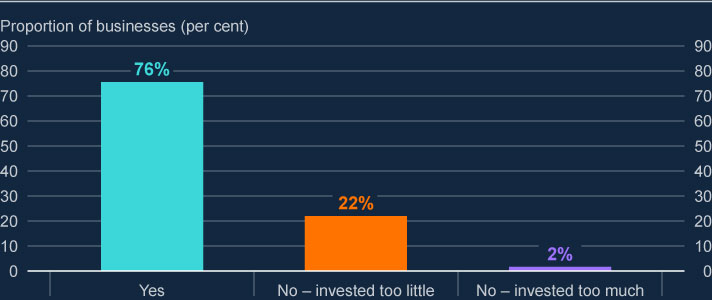
Footnotes
Motivation to invest, types of investment and sources of finance
Motivation to invest and types of investment
As much as the level of investment, the type and reasons for investment are also important factors driving business productivity. Businesses surveyed were asked about the type of investment they made (Chart 2) and the underlying motivation (Chart 3). Investment in technology or IT (60%) was the most common type of investment carried out by businesses, followed by acquisition of plant, machinery and vehicles and staff training (both 52%). Nearly 30% of businesses reported investing in new product development and R&D.
Chart 2: Investment types carried out by businesses (a)
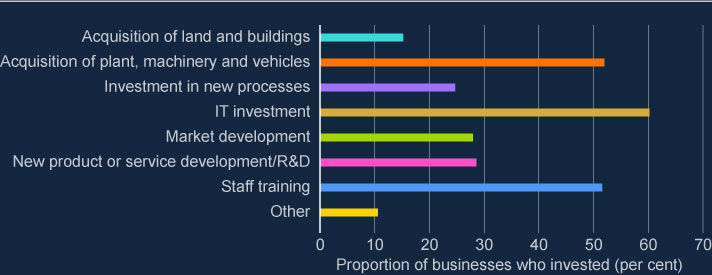
Footnotes
- Source: Bank of England Finance and Investment Decisions Survey.
- (a) Chart shows the proportion of businesses who stated investing in each type of investment out of the businesses who reported investing. Question: ‘Can you tell me in which of the following areas you made your investment?’. This is a count – Number of businesses who invested in type of investment/total number of businesses who invested.
The survey found that of the businesses that invested in the preceding three years, around 60% invested in IT, and around 50% invested in new plant and machinery and staff training. When asked about their underlying motivations for investment, boosting productivity or business growth and maintaining the business were the most cited reasons (Chart 3).
Chart 3: Purpose of investment split by investment type (a)
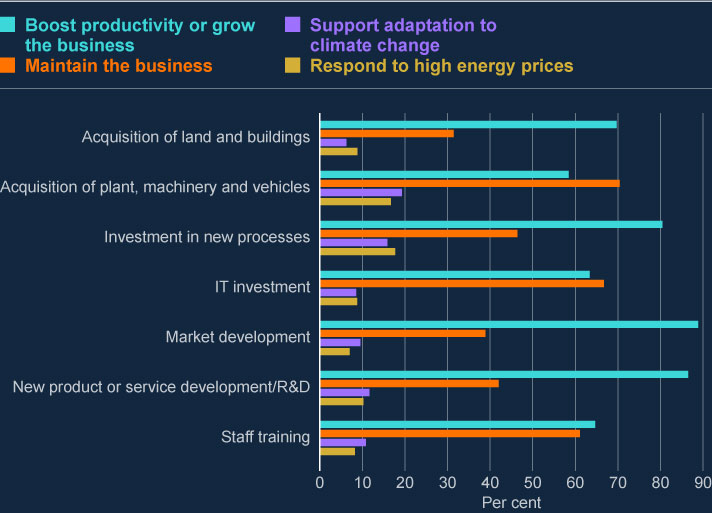
Footnotes
- Source: Bank of England Finance and Investment Decisions Survey.
- (a) Chart shows the proportion of businesses who stated each motivation for investing in each area of investment, out of those who invested in each area of investment. Question: ‘For each type of investment pursued – What was the purpose of each investment?’. This is a count – Number of businesses stating purpose of investment/total number of businesses who invested in each type of investment.
Sources of finance
According to the ‘pecking order’ theory, when financing investment, businesses will tend to turn to internal funds, the cheapest source of finance, first, followed by the more expensive debt and then equity finance.footnote[4] Businesses were asked the types of funding used for their investment (Chart 4). Over 80% of the businesses that invested reported that they used at least some internal funds to finance investment, while 50% businesses used only internal funds. That is, half of businesses did not use external financing at all.footnote[5] Bank debt, personal funds and trade credit were the most widely used external sources of finance, while the use of non-bank debt and equity finance was low.
The survey is also able to shed light on the extent to which businesses use diverse sources of finance for their investment. Around 40% of businesses used two or more sources of finance to fund investment, and the rest used a single type of finance (Chart 5). Overall, these findings highlight the importance of internal funds and bank loans for investment by SMEs. The use of alternative sources of finance, such as non-bank debt, appears limited.
Chart 4: Types of finance used to fund investment (a)
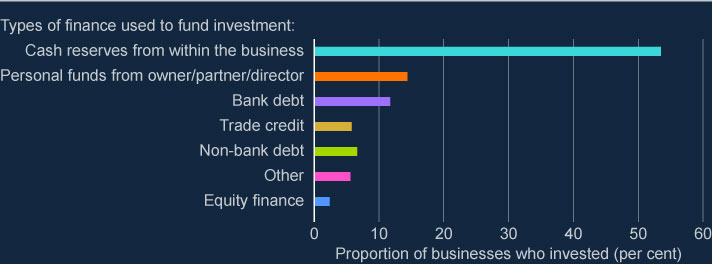
Footnotes
- Source: Bank of England Finance and Investment Decisions Survey.
- (a) Chart shows the proportion of businesses who stated using each type of finance to fund investment, out of those who invested. Question: ‘Thinking about how you financed these investments, which of the following did you use?’. This is a count of the number of businesses stating using each type of finance used to fund investment/total number of businesses who invested.
Chart 5: The number of types of finance used to fund investment (a)
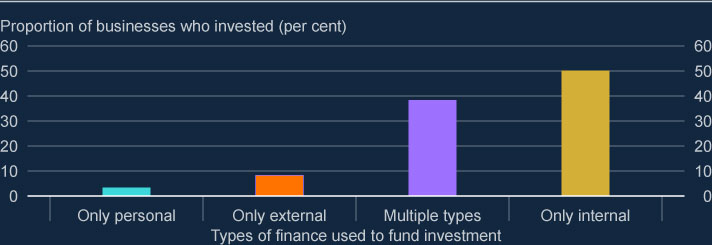
Footnotes
- Source: Bank of England Finance and Investment Decisions Survey.
- (a) Chart shows the number of types of finance used by businesses to fund investment. Question: ‘Thinking about how you financed these investments, which of the following did you use?’. Internal includes Cash reserves from within the business, Personal includes Personal funds from owner/partner/director, External includes Trade credit, Bank debt, non-bank debt, Equity finance, Other. Multiple types contain businesses who stated more than one type of broad finance category. This is a count – Number of businesses stating types of finance used to fund investment/total number of businesses who invested in each type of investment.
What are some of the reasons for underinvestment?
In this section we zoom into the findings from the subset of firms that reported underinvesting in order to understand the reasons for that. Around 22% of businesses said that they invested too little over the three years preceding the survey. In the survey, businesses were given a range of potential reasons for that underinvestment, including real economic obstacles, like uncertainty around the economic environment and lack of transport infrastructure, and financial obstacles, like lack of internal funds or inability to access external finance (Chart 6).
The most commonly reported reason was uncertainty about the economic environment (36%). This is consistent with the latest SME Finance Monitor surveyOpens in a new window by BVA BDRC, suggesting 30% to 35% of SMEs have seen the current economic environment as a major obstacle to investing since 2022. Inability to self-fund from cash reserves (29%) and inability to access finance on reasonable terms (20%) were also commonly cited reasons. The free text ‘Other’ option in Chart 6 captured similar reasons for investing too little. Some of the recurring themes in the free text were inability to access debt finance on reasonable terms, economic uncertainty and reluctance to take on risk.
Chart 6: Reasons for investing too little (a)
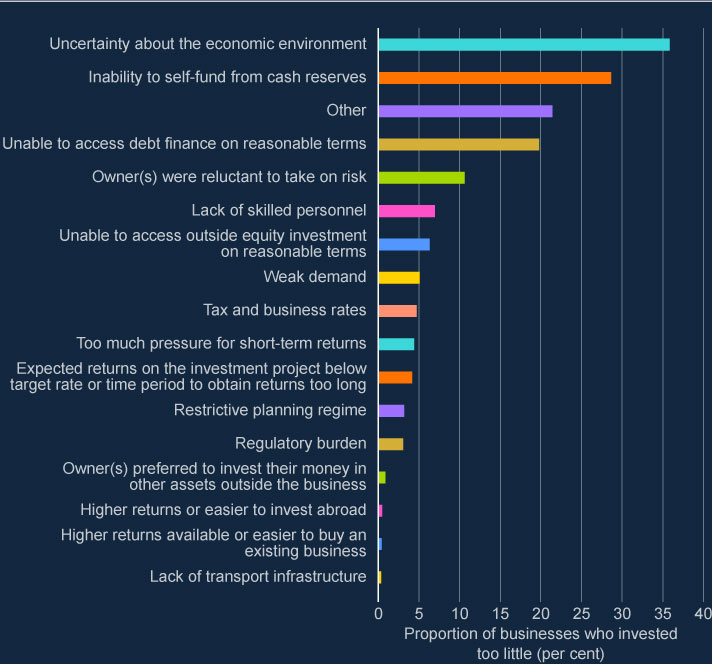
Footnotes
- Source: Bank of England Finance and Investment Decisions Survey.
- (a) Chart shows the proportion of businesses who stated each obstacle to investment, out of those who said they invested ‘too little’. Question: ‘If your business invested ‘too little’ over the past three years, what were the obstacles to investing/reasons for not having invested more?’. This is a count of the number of businesses stating each obstacle/total number of businesses who invested too little. Other includes responses such as needing government support, market conditions and investment taking a long time.
3: Underlying issues in SMEs accessing external finance
This section discusses financial obstacles in more detail, including both supply and demand-side barriers to use of external finance. While supply-side constraints do seem to be important, demand-side factors, such as risk aversion and deleveraging motives also drive low SME usage of external finance.
Supply-side factors
Constraints on the supply of finance affected the investment decisions of a number of the businesses surveyed. Chart 7 compares the responses of businesses that reported that they had invested too little with those that said they had invested appropriately. Of those that had invested too little, 58% cited credit to be too expensive, 55% said that they could not borrow at a reasonable rate, 33% cited lack of enough collateral to borrow, and 29% believed that their application would be unsuccessful. Across the board, businesses that perceived themselves as having invested appropriately were less negative regarding access to finance, relative to businesses who perceived themselves to have invested too little. This highlights an important correlation between businesses’ perceptions of the appropriateness of their investment levels and access to finance.
Chart 7: Perceptions of access to finance by investment level (a)
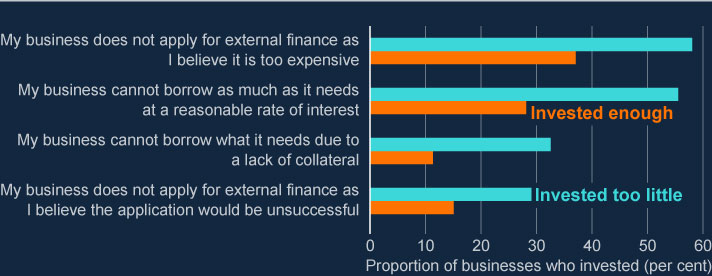
Footnotes
- Source: Bank of England Finance and Investment Decisions Survey.
- (a) Chart focuses on businesses who invested enough and those invested too little. The aqua bars show the proportion of businesses who invested too little who agreed with the statements around perceptions of access to finance. The orange bars show the proportion of businesses who invested enough who agreed with the statements around perceptions of access to finance. Question: ‘Do you agree or disagree with each of the following statements?’.
A sizeable fraction of businesses reported what they perceive as ‘strict’ collateral requirements and high cost of credit as the reasons for not seeking external finance. Around 22% of businesses reported that they invested too little over the three years preceding the survey (Chart 1). Out of these 22% of businesses that invested too little, around a third cited collateral constraints (Chart 7) which for illustration roughly translates to 7% of firms. The lack of collateral could be related to a higher proportion of intangibles investment. Intangible capital is less easy to pledge as collateral with creditors and the difficulty of posting collateral could make borrowing constraints more likely to bind for intangible-intensive firms.footnote[6]
Over 50% of firms who invested too little cited cost of finance as a significant factor (Chart 7). This is especially important in the current conjuncture. Since the pandemic, interest rates on new lending to corporates have increased roughly in line with Bank Rate. The price of corporate credit has now increased to similar levels to those prevailing before the global financial crisis (Chart 8). Higher SME financing costs affect businesses existing debt with variable interest rates in addition to any new borrowing. This has knock-on implications for borrower resilience and spending (including expenditure on investment).
Chart 8: Effective rates on new lending to private non-financial companies (PNFCs) and SMEs (a)
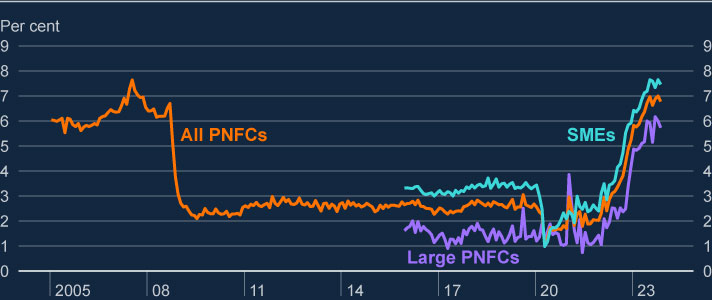
Footnotes
- Sources: Bank of England Bankstats and Bank calculations.
- (a) Chart shows the effective interest rate on new lending to all PNFCS, SMEs and large businesses over time.
The survey asked businesses that used external finance about the types of external finance they used (Chart 9). Credit cards, leasing or hire purchase, and bank overdrafts associated with current accounts were the most commonly used. Government-guaranteed loans available during the pandemic were also an important source of finance. SMEs have extremely limited usage of market-based finance, with well over 80% stating they have never used equity finance or market-based debt finance.
Chart 9: Types of finance used (a)
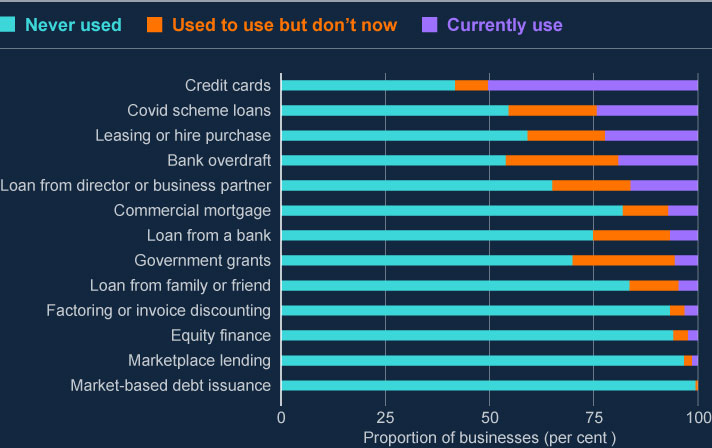
Footnotes
- Source: Bank of England Finance and Investment Decisions Survey.
- (a) Chart shows the proportion of businesses which stated their current relationship with each type of finance out of the total survey sample. Question: ‘What best describes your relationship with these sources of external finance?’. Options ‘Currently use’, ‘Used to use but don’t now’, ‘Never used’.
To examine potential barriers to accessing finance, the survey asked specific questions of businesses that sought external finance for investment but didn’t end up using any (Chart 10). Around 15% of businesses reported that they were prevented from using external finance for investment because it was too expensive, and over 10% reported not taking finance because they were not offered the amount they wanted. Other reasons cited were not wanting to lose control of the business and not wanting to give the security that the financier had asked for. Operational barriers included too many terms and conditions associated with financing, and financiers taking too long to make a decision.
Chart 10: Barriers to accessing finance (a)
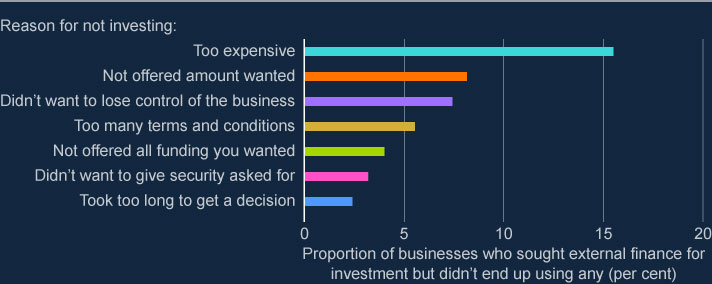
Footnotes
- Source: Bank of England Finance and Investment Decisions Survey.
- (a) Chart shows the proportion of businesses who stated each barrier to finance, out of those who sought external finance but didn’t use any. Question: ‘You said you sought external finance for investment but didn’t end up using any. What prevented you from using external finance to fund your investment?’.
Demand-side factors
The academic literature has extensively analysed constraints on the supply of finance to businesses (eg, Khwaja and Mian (2008)Opens in a new window and Degryse et al (2021)Opens in a new window), but has left businesses’ demand for finance relatively understudied. While the finding that SMEs are heavily reliant on internal funding is consistent with other surveysOpens in a new window, a novel feature of this survey is to shed light on the drivers of SMEs’ demand for finance. The survey results suggest that risk aversion and deleveraging were the main motives behind low demand for finance.
Risk aversion
The respondents indicated a high degree of risk aversion towards accessing external finance (Chart 11). 77% of businesses agreed with the statement that they would accept a slower growth rate rather than borrowing to grow at a faster rate. Only 7% of businesses disagreed with the statement, showing SMEs strong aversion to having debt.
Chart 11: Business’s feelings towards using finance (a)
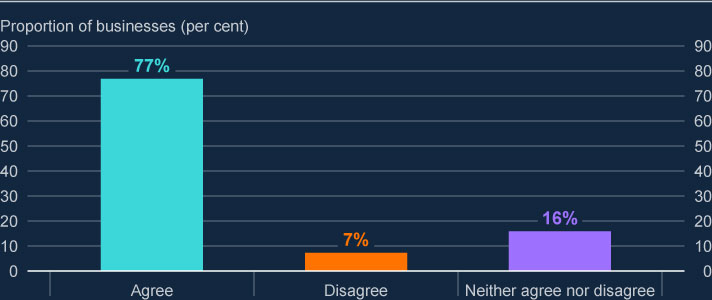
Footnotes
- Source: Bank of England Finance and Investment Decisions Survey.
- (a) Chart shows the proportion of businesses who stated their feelings towards using finance to grow faster. To what extent do you agree or disagree with the following statement – ‘as a business, we will accept a slower growth rate rather than borrowing to grow faster’?
De-leveraging
Around 75% of businesses in the survey agreed with the statement: ‘I would like my business to pay down debt/be debt free’. This may be due in part to that fact that businesses want to pay down debt, as financing terms may not be as favourable as before due to higher interest rates. During the pandemic, many SMEs took on debt for the first time through government-guaranteed Covid loan schemes, which were bank loans issued on favourable terms. Since then, funding costs have increased with the rise in interest rates and the Covid government support schemes are naturally closed to new borrowing. This means refinancing on commercial terms may not be attractive to businesses. Intelligence gathered by the Bank’s regional agents also points to businesses paying down debt they took on during the Covid pandemic, as well as an ongoing disinclination to borrow to invest given the uncertain economic environment.
The above finding and explanation are consistent with aggregate data on corporate borrowing. Net bank lending to businesses has grown slowly in recent years. For SMEs in particular, the growth rate of net lending has been negative since September 2021 (Chart 12). Cross-examining the gross lending and repayments by SMEs reveals two notable points: first, that repayments are above their long-run average; and second, that gross lending has decreased to its long-term average (Chart 13). This is consistent with the survey result of 75% of businesses wanting to pay down debt.
Chart 12: Twelve-month growth rate of net lending to PNFCs split by size (a)
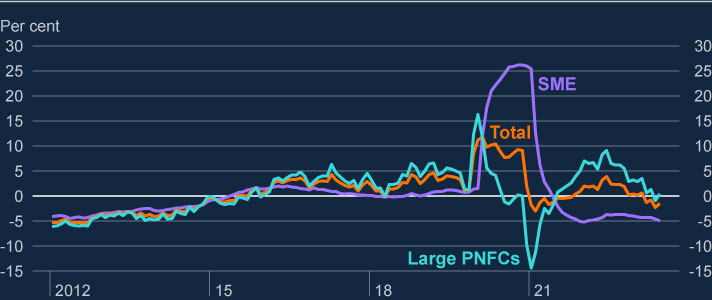
Footnotes
- Source: Bank calculations.
- (a) Chart shows the yearly growth rate in lending to PNFCs, split by business size.
Chart 13: Flows of gross lending and repayments by SMEs (a)
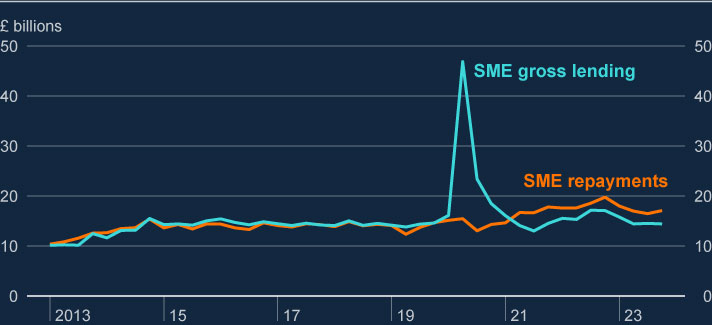
Footnotes
4: Conclusions
This article reports the findings from the Bank’s Finance and Investment Decisions Survey, carried out in 2023 and run in collaboration with the Department for Business and Trade. Around three quarters of businesses said that their investment levels were appropriate over the preceding three years, but around a quarter said they underinvested. Financial constraints (high borrowing costs and strict collateral requirements) and economic uncertainty were the key reasons cited for underinvestment. Businesses that underinvested also tended to have less positive perceptions of their access to finance than those that perceived their investment levels as appropriate.
Boosting productivity and maintaining the business were the main motivators cited for undertaking investment. A significant fraction of businesses had invested in R&D and intangibles. Existing research shows a positive association between intangibles and future productivity. Consistent with other surveysOpens in a new window, this survey also found that half of the businesses used only internal funds to finance investment. But an important finding of this survey was that about 70% preferred to grow less to having debt, suggesting the importance of demand-side factors, such as risk aversion, a desire to retain control, and deleveraging motives in explaining the low use of external finance among SMEs. Of the businesses that had used external finance, the results also suggested bank debt continues to be an important source of finance for SMEs. On the other hand, the reported use of non-bank finance or market-based debt was very limited.
The results of this survey highlight a few policy areas, where more research could be done to examine the interaction between access to finance and productivity-enhancing investment for SMEs. In particular, two open issues or questions that could be explored in future research and policy analysis of SMEs include:
- bring together views from the businesses and banks to understand how easing supply-side constraints and/or developing more equity style financingOpens in a new window could foster productivity enhancing investments; and
- how can the demand-side barriers holding back external finance usage be reduced?


























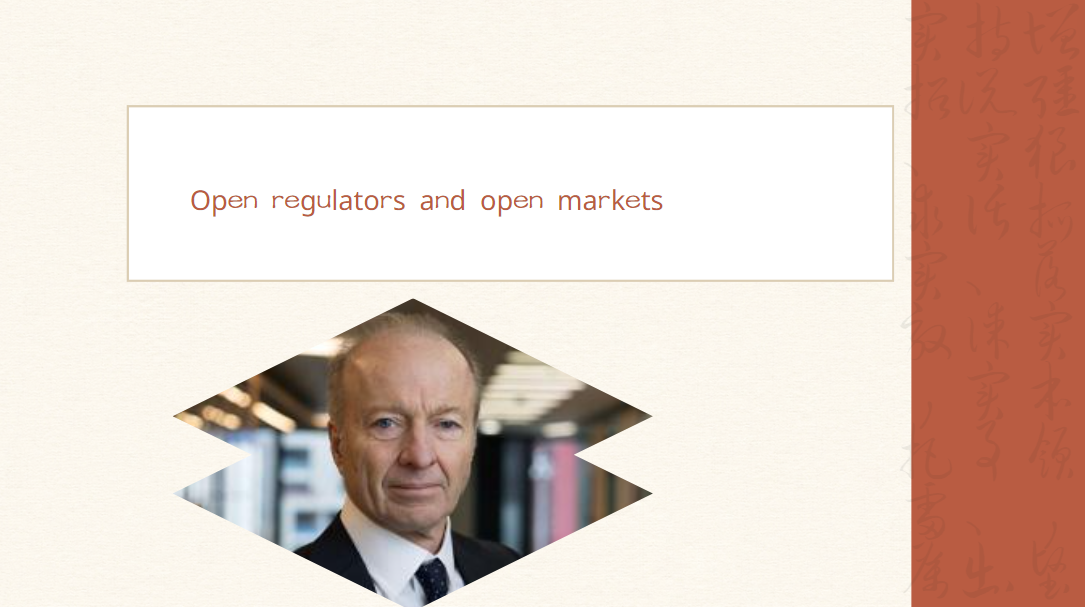




























First, please LoginComment After ~